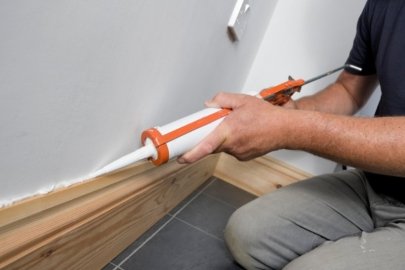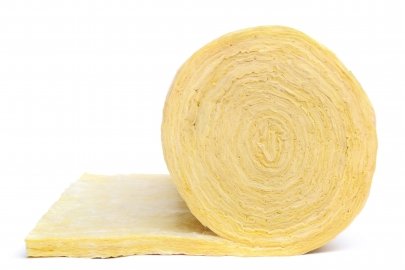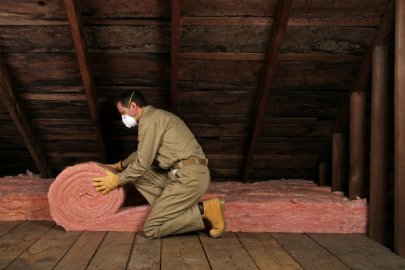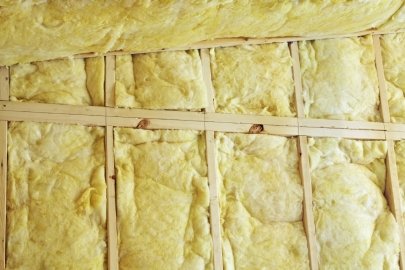In most U.S. climates, vapor barriers, or -- more accurately -- vapor diffusion retarders (vapor retarders), should be part of a moisture control strategy for a home. A vapor retarder is a material that reduces the rate at which water vapor can move through a material. The older term "vapor barrier" is still used even though "vapor retarder" is more accurate.
The ability of a material to retard the diffusion of water vapor is measured in units known as "perms" or permeability. The International Residential Code describes three classes of water vapor retarders:
Class I vapor retarders (0.1 perms or less):
- Glass
- Sheet metal
- Polyethylene sheet
- Rubber membrane
Class II vapor retarders (greater than 0.1 perms and less than or equal to 1.0 perms):
- Unfaced expanded or extruded polystyrene
- 30 pound asphalt coated paper
- Plywood
- Bitumen coated kraft paper
Class III vapor retarders (greater than 1.0 perms and less than or equal to 10 perms):
- Gypsum board
- Fiberglass insulation (unfaced)
- Cellulose insulation
- Board lumber
- Concrete block
- Brick
- 15-pound asphalt coated paper
- House wrap
Vapor retarders can help control moisture in:
- Basements
- Ceilings
- Crawlspaces
- Floors
- Slab-on-grade foundations
- Walls
Effective moisture control in these areas and throughout a home must also include air-sealing gaps in the structure, not just the use of a vapor retarder. How, where, and whether you need a vapor retarder depends on the climate and the construction of your home.
Types of Vapor Retarders
Vapor retarders are typically available as membranes or coatings. Membranes are generally thin, flexible materials, but also include thicker sheet materials sometimes called "structural" vapor retarders. Materials such as rigid foam insulation, reinforced plastics, aluminum, and stainless steel are relatively resistant to water vapor diffusion. These types of vapor retarders are usually mechanically fastened and sealed at the joints.
Thinner membrane types come in rolls or as integral parts of building materials. Common examples include polyethylene sheeting and aluminum- or paper-faced fiberglass roll insulation. Another type is foil-backed wallboard. Most paint-like coatings also retard vapor diffusion.
Installing Vapor Retarders for New Construction
In mild climates, materials like painted gypsum wallboard and plaster wall coatings may be enough to impede moisture diffusion. In more extreme climates, higher-perm vapor diffusion retarders are advisable for new construction. They perform best when installed closest to the warm side of a structural assembly -- toward the interior of the building in cold climates and toward the exterior in hot/wet climates.
Vapor retarder installation should be continuous and as close to perfect as possible. This is especially important in very cold climates and in hot and humid climates. Be sure to completely seal any tears, openings, or punctures that may occur during construction. Cover all appropriate surfaces or you risk moist air condensing within the cavity, which could lead to dampened insulation. The thermal resistance of wet insulation is dramatically decreased, and prolonged wet conditions will encourage mold and wood rot.
Installing Vapor Retarders in Existing Homes
Except for extensive remodeling projects, it's difficult to add materials like sheet plastic as a vapor retarder to an existing home. Obtaining an energy assessment and thoroughly sealing any leaks it reveals is are very effective for slowing moisture movement in and out of your home.
Your home may not need a more effective vapor retarder than the numerous layers of paint on its walls and ceilings unless you live in extreme northern climates. "Vapor barrier" paints can be an effective option for existing homes in colder climates. If the perm rating of the paint is not indicated on the label, find the paint formula. The paint formula usually indicates the percent of pigment. To be a good vapor retarder, it should consist of a relatively high percent of solids and thickness in application. Glossy paints are generally more effective vapor retarders than flat paints, and acrylic paints are generally better than latex paints. When in doubt, apply more coats of paint. It's best to use paint labeled as a vapor diffusion retarder and follow the directions for applying it.
Subscribe to receive updates from Energy Saver, including new blogs, updated content, and seasonal energy saving tips for consumers and homeowners.
-
 Controlling moisture can make your home more energy-efficient, less costly to heat and cool, and more comfortable.
Controlling moisture can make your home more energy-efficient, less costly to heat and cool, and more comfortable. -
 Learn about the best techniques and materials for minimizing air leakage when building a new home.
Learn about the best techniques and materials for minimizing air leakage when building a new home. -
 Consumers can choose from among many types of insulation that save money and improve comfort.
Consumers can choose from among many types of insulation that save money and improve comfort. -
 Find product information and locate professional services for insulation and air sealing.
Find product information and locate professional services for insulation and air sealing.


